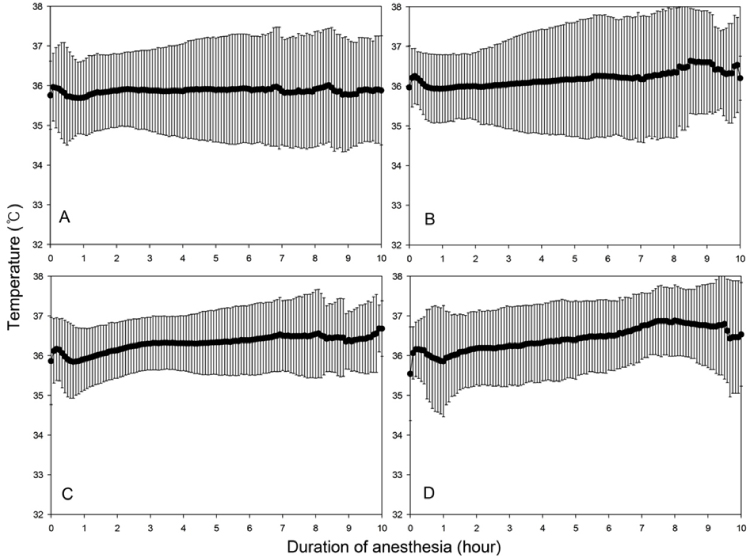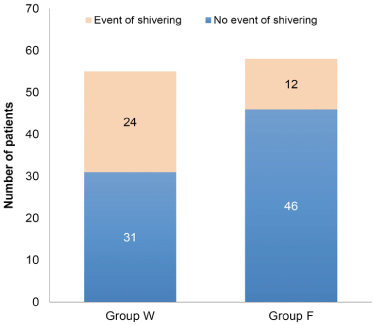J Dent Anesth Pain Med.
2015 Dec;15(4):193-200.
Clinical considerations in the use of forced-air warming blankets during orthognathic surgery to avoid postanesthetic shivering
- Affiliations
-
- 1Department of Dental Anesthesiology, the Graduate School, Seoul National University, Seoul, Korea.
- 2Department of Dental Anesthesiology, Seoul National University Dental Hospital, Seoul, Korea. stone90@snu.ac.kr
- 3Department of Dental Anesthesiology, Dental Research Institute, School of Dentistry, Seoul National University, Seoul, Korea.
Abstract
- BACKGROUND
During head and neck surgery including orthognathic surgery, mild intraoperative hypothermia occurs frequently. Hypothermia is associated with postanesthetic shivering, which may increase the risk of other postoperative complications. To improve intraoperative thermoregulation, devices such as forced-air warming blankets can be applied. This study aimed to evaluate the effect of supplemental forced-air warming blankets in preventing postanesthetic shivering.
METHODS
This retrospective study included 113 patients who underwent orthognathic surgery between March and September 2015. According to the active warming method utilized during surgery, patients were divided into two groups: Group W (n = 55), circulating-water mattress; and Group F (n = 58), circulating-water mattress and forced-air warming blanket. Surgical notes and anesthesia and recovery room records were evaluated.
RESULTS
Initial axillary temperatures did not significantly differ between groups (Group W = 35.9 ± 0.7℃, Group F = 35.8 ± 0.6℃). However, at the end of surgery, the temperatures in Group W were significantly lower than those in Group F (35.2 ± 0.5℃ and 36.2 ± 0.5℃, respectively, P = 0.04). The average body temperatures in Groups W and F were, respectively, 35.9 ± 0.5℃ and 36.2 ± 0.5℃ (P = 0.0001). In Group W, 24 patients (43.6%) experienced postanesthetic shivering, while in Group F, only 12 (20.7%) patients required treatment for postanesthetic shivering (P = 0.009, odds ratio = 0.333, 95% confidence interval: 0.147-0.772).
CONCLUSIONS
Additional use of forced-air warming blankets in orthognathic surgery was superior in maintaining normothermia and reduced the incidence of postanesthetic shivering.
Keyword
MeSH Terms
Figure
Reference
-
1. Horosz B, Malec-Milewska M. Inadvertent intraoperative hypothermia. Anaesthesiol Intensive Ther. 2013; 45:38–43.2. Garg M, Cascarini L, Coombes DM, Walsh S, Tsarouchi D, Bentley R, et al. Multicentre study of operating time and inpatient stay for orthognathic surgery. Br J Oral Maxillofac Surg. 2010; 48:360–363.
Article3. Thomas AA, Rittersma J. Anaesthetic experiences in orthodontic surgery. J Maxillofac Surg. 1978; 6:204–206.
Article4. Warttig S, Alderson P, Campbell G, Smith AF. Interventions for treating inadvertent postoperative hypothermia. Cochrane Database Syst Rev. 2014; 11:CD009892.
Article5. Reynolds L, Beckmann J, Kurz A. Perioperative complications of hypothermia. Best Pract Res Clin Anaesthesiol. 2008; 22:645–657.
Article6. Díaz M, Becker DE. Thermoregulation: Physiological and clinical considerations during sedation and general anesthesia. Anesth Prog. 2010; 57:25–32.
Article7. Torossian A, Brauer A, Hocker J, Bein B, Wulf H, Horn EP. Preventing inadvertent perioperative hypothermia. Dtsch Arztebl Int. 2015; 112:166–172.
Article8. Scott EM, Buckland R. A systematic review of intraoperative warming to prevent postoperative complications. AORN J. 2006; 83:1090–1113.
Article9. Sessler DI. Temperature monitoring and perioperative thermoregulation. Anesthesiology. 2008; 109:318–338.
Article10. Casati A, Baroncini S, Pattono R, Fanelli G, Bonarelli S, Musto P, et al. Effects of sympathetic blockade on the efficiency of forced-air warming during combined spinal-epidural anesthesia for total hip arthroplasty. J Clin Anesth. 1999; 11:360–363.
Article11. Kim HY, Lee KC, Lee MJ, Kim MN, Kim JS, Lee WS, et al. Comparison of the efficacy of a forced-air warming system and circulating-water mattress on core temperature and post-anesthesia shivering in elderly patients undergoing total knee arthroplasty under spinal anesthesia. Korean J Anesthesiol. 2014; 66:352–357.
Article12. Moola S, Lockwood C. Effectiveness of strategies for the management and/or prevention of hypothermia within the adult perioperative environment. Int J Evid Based Healthc. 2011; 9:337–345.
Article13. Insler SR, Sessler DI. Perioperative thermoregulation and temperature monitoring. Anesthesiol Clin. 2006; 24:823–837.
Article14. NICE. Clinical-practice-guideline, the management of inadvertent perioperative hypothermia in adults. 2008.15. Tekgul ZT, Pektas S, Yildirim U, Karaman Y, Cakmak M, Ozkarakas H, et al. A prospective randomized double-blind study on the effects of the temperature of irrigation solutions on thermoregulation and postoperative complications in percutaneous nephrolithotomy. J Anesth. 2015; 29:165–169.
Article16. Torossian A. Survey on intraoperative temperature management in europe. Eur J Anaesthesiol. 2007; 24:668–675.
Article17. NICE. Inditherm patient warming mattress for the prevention of inadvertent hypothermia. National Institute for Health and Clinical Excellence. 2011.18. Singh P, Dimitriou V, Mahajan RP, Crossley AW. Double-blind comparison between doxapram and pethidine in the treatment of postanaesthetic shivering. Br J Anaesth. 1993; 71:685–688.
Article19. Mohta M, Kumari N, Tyagi A, Sethi AK, Agarwal D, Singh M. Tramadol for prevention of postanaesthetic shivering: A randomised double-blind comparison with pethidine. Anaesthesia. 2009; 64:141–146.
Article20. Casey WF, Smith CE, Katz JM, O'Loughlin K, Weeks SK. Intravenous meperidine for control of shivering during caesarean section under epidural anaesthesia. Can J Anaesth. 1988; 35:128–133.
Article21. Alfonsi P. Postanaesthetic shivering: Epidemiology, pathophysiology, and approaches to prevention and management. Minerva Anestesiol. 2003; 69:438–442.22. Sessler DI, Rubinstein EH, Moayeri A. Physiologic responses to mild perianesthetic hypothermia in humans. Anesthesiology. 1991; 75:594–610.
Article23. Leslie K, Sessler DI. Perioperative hypothermia in the high-risk surgical patient. Best Pract Res Clin Anaesthesiol. 2003; 17:485–498.
Article24. Horn EP, Sessler DI, Standl T, Schroeder F, Bartz HJ, Beyer JC, et al. Non-thermoregulatory shivering in patients recovering from isoflurane or desflurane anesthesia. Anesthesiology. 1998; 89:878–886.
Article25. Lienhart A, Fiez N, Deriaz H. Postoperative shivering: Analysis of main associated factors. Ann Fr Anesth Reanim. 1992; 11:488–495.26. Lyons B, Taylor A, Power C, Casey W. Postanaesthetic shivering in children. Anaesthesia. 1996; 51:442–445.
Article27. Camus Y, Delva E, Cohen S, Lienhart A. The effects of warming intravenous fluids on intraoperative hypothermia and postoperative shivering during prolonged abdominal surgery. Acta Anaesthesiol Scand. 1996; 40:779–782.
Article
- Full Text Links
- Actions
-
Cited
- CITED
-
- Close
- Share
- Similar articles
-
- Perioperative cutaneous complications in an elderly patient due to inappropriate use of a forced-air warming device and underbody blanket: a case report
- Effects of Forced Air Warming on Body Temperature, Shivering and Pain in Laparoscopic Cholecystectomy Patients
- Effects of Forced-Air Warming Therapy on Anxiety, Pain, and Body Temperature of Patients under Local Anesthesia during Surgery: A Quasi-Experimental Study
- Comparison of upper and lower body forced air blanket to prevent perioperative hypothermia in patients who underwent spinal surgery in prone position: a randomized controlled trial
- Comparison of the efficacy of a forced-air warming system and circulating-water mattress on core temperature and post-anesthesia shivering in elderly patients undergoing total knee arthroplasty under spinal anesthesia




